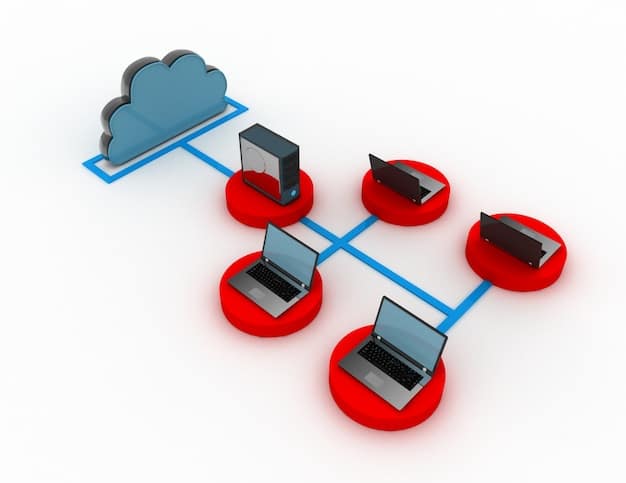Cloud Security Best Practices for US Companies: 2025 Update

Cloud security best practices for US companies in 2025 encompass a comprehensive approach to protecting data and infrastructure, addressing evolving threats through updated strategies, compliance measures, and proactive security protocols.
The cloud offers unparalleled scalability and flexibility, but it also introduces unique security challenges. Staying ahead of these challenges requires a robust and constantly evolving security strategy. This article outlines the crucial Cloud Security Best Practices for US Companies: Updated January 2025.
Understanding the Evolving Cloud Threat Landscape
The cloud threat landscape is constantly changing. New vulnerabilities emerge, and attackers develop increasingly sophisticated techniques. To effectively protect your cloud environment, you need to understand the current threats and how they might impact your organization.
Common Cloud Security Threats
Several threats consistently target cloud environments. These include data breaches, malware infections, denial-of-service attacks, and account hijacking. Each of these can have a significant impact on your business.
- Data Breaches: Unauthorized access and exfiltration of sensitive data.
- Malware Infections: Introduction of malicious software that can compromise systems.
- Denial-of-Service (DoS) Attacks: Overwhelming systems with traffic to make them unavailable.
- Account Hijacking: Gaining control of user accounts to access resources.
Businesses need to stay informed about these threats to implement the strategies required to protect their cloud infrastructure. In the coming year they will need to keep up with advances in AI and machine learning based threat detection.

Proper cloud security relies on having the best understanding of the threat landscape. As the environment changes, policies and measures must change too.
Implementing Strong Identity and Access Management (IAM)
Identity and Access Management (IAM) is the cornerstone of cloud security. Controlling who has access to your resources, and what they can do with them, is crucial for preventing unauthorized access and data breaches.
Multi-Factor Authentication (MFA)
Implementing MFA is one of the most effective ways to prevent account hijacking. MFA requires users to provide multiple forms of authentication, such as a password and a code from their smartphone, making it more difficult for attackers to gain access.
Principle of Least Privilege
Adhering to the principle of least privilege means granting users only the minimum level of access they need to perform their job functions. This reduces the potential impact of a compromised account.
- Regular Audits: Review user access rights regularly to ensure they are still appropriate.
- Role-Based Access Control (RBAC): Assign permissions based on job roles rather than individual users.
- Strong Password Policies: Enforce strong password requirements and encourage regular password changes.
Proper implementation of IAM is the first step in cloud security, as it sets the stage for controlling how your valuable data is accessed.
Data Encryption: Protecting Data at Rest and in Transit
Data encryption is essential for protecting sensitive information stored in the cloud. Encryption scrambles data, making it unreadable to unauthorized users. This ensures that even if a breach occurs, the data remains protected.
Encryption Best Practices
Using strong encryption algorithms, managing encryption keys securely, and encrypting data both at rest and in transit, helps keep your US company’s data protected and secure.
Data encryption should be used to protect the confidentiality, integrity, and authenticity of data. It prevents adversaries from being able to steal customer data.
- Data at Rest: Encrypting data stored on cloud servers and storage devices.
- Data in Transit: Encrypting data as it moves between systems and locations.
- Key Management: Securely storing and managing encryption keys.
Without data encryption, all other procedures are secondary to protecting your cloud environment. Even proper IAM and network firewalls cannot help defend if the actual data your company holds is somehow compromised in its rawest form.
Network Security: Implementing Firewalls and Intrusion Detection Systems
Network security is another critical component of cloud security. Implementing firewalls and intrusion detection systems helps to protect your cloud environment from unauthorized access and malicious activity. It is best to use these systems in combination with other methods. They also need to be updated regularly as new threats are discovered.
Firewalls act as barriers, controlling network traffic and blocking unauthorized access. Intrusion detection systems monitor network traffic for suspicious activity and alert security personnel.
Firewall and IDS Best Practices
Regularly review and update firewall rules, implement intrusion detection systems, and monitor network traffic for suspicious activity to keep your data safe.
Businesses need to ensure that they are actively monitoring network traffic and proactively investigating suspicious activity. The sooner a breach is caught and dealt with, the less damage occurs.

Together, these measures help strengthen cloud protections and reduce the likelihood of threats against your cloud infrastructure.
Compliance and Governance: Meeting Regulatory Requirements
Compliance and governance are essential aspects of cloud security, especially for US companies that must adhere to various regulatory requirements. This includes complying with laws such as HIPAA, PCI DSS, and GDPR, which dictate how sensitive data must be protected.
Key Compliance Considerations
Understand the regulatory requirements that apply to your industry and region, implement appropriate security controls, and regularly audit your compliance posture.
Compliance and governance measures should cover everything from how data is collected to how it is stored and accessed. They should also be incorporated with third party vendors that your organization works with.
- HIPAA: Protecting health information.
- PCI DSS: Securing credit card data.
- GDPR: Protecting personal data.
Compliance and governance are key for building trust with customers and ensuring your operations are legal. Working with outside experts or regulatory authorities can help to ensure that all aspects of cloud security are covered.
Regular Security Assessments and Penetration Testing
Regular security assessments and penetration testing are crucial for identifying and addressing vulnerabilities in your cloud environment. These activities help you to proactively identify weaknesses before attackers can exploit them.
Benefits of Security Assessments
Security assessments provide a comprehensive review of your security posture, identifying areas for improvement. Penetration testing simulates real-world attacks to uncover vulnerabilities.
It is important for businesses to use a combination of automated tools, manual techniques, and expert guidance. Also, it is important to ensure that any third-party assessment and penetration testing providers you work with are trustworthy and understand your organization’s data needs.
- Vulnerability Scanning: Automated tools that identify known vulnerabilities.
- Penetration Testing: Simulating attacks to test security controls.
- Security Audits: Comprehensive reviews of security policies and procedures.
Security assessments and penetration testing help keep your business protected against bad actors who have nefarious intentions.
| Key Point | Brief Description |
|---|---|
| 🛡️ Implement IAM | Control access with MFA and least privilege. |
| 🔑 Encrypt Data | Protect data at rest and in transit with strong encryption. |
| 🚨 Network Security | Use firewalls and intrusion detection systems. |
| ⚖️ Compliance | Meet regulatory requirements like HIPAA and PCI DSS. |
Frequently Asked Questions
▼
The biggest threat continues to be data breaches, especially those resulting from misconfigured cloud services or compromised credentials. Addressing these vulnerabilities remains a key priority.
▼
MFA adds an extra layer of security by requiring users to provide multiple forms of identification. This makes it significantly harder for attackers to access accounts even if they have the password.
▼
Data encryption helps ensures that sensitive information remains unreadable to unauthorized users, even if a breach occurs, thus protecting the confidentiality and integrity of data.
▼
Penetration testing simulates real-world attacks to uncover vulnerabilities in your cloud environment before attackers can exploit them. It validates the effectiveness of security controls.
▼
Security assessments should be performed regularly, at least annually, and ideally more frequently if your threat landscape is rapidly evolving or if you are making significant changes to your infrastructure.
Conclusion
Implementing these Cloud Security Best Practices for US Companies: Updated January 2025, is essential for securing your cloud environment and protecting your sensitive data. By understanding the evolving threat landscape, implementing strong security controls, and regularly assessing your security posture, you can mitigate risks and maintain a secure cloud operation.





